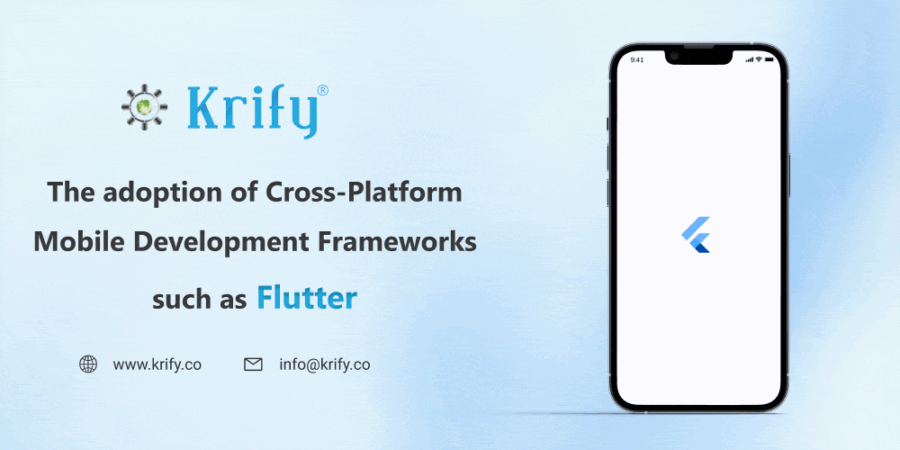The Adoption of Cross-Platform Mobile Development Frameworks such as Flutter
The demand for mobile applications is constantly increasing in today’s fast-paced world. However, creating an app that works perfectly across iOS and Android platforms can be difficult. To address this issue, cross-platform mobile development tools such as Xamarin, React Native, and Flutter have emerged. Flutter, in particular, has gained popularity due to its unique features and capabilities. In this article, I’ll explain why Flutter is the future of cross-platform mobile development and what advantages it provides developers.
Introduction to Flutter
Google’s Flutter is an open-source mobile application development framework. It was first released in 2017, and it has since become one of the market’s most popular cross-platform mobile development tools. Flutter allows developers to use a single codebase to create high-performance, visually appealing, and natively compiled applications for mobile, web, and desktop platforms.
Dart, a client-optimized programming language that is simple to learn and understand, is used by Flutter. Flutter allows developers to create applications with a shorter development cycle, allowing them to develop, test, and deploy applications more quickly. Flutter also includes a plethora of pre-built widgets, making it easier for developers to create engaging user interfaces.
Benefits of Flutter for cross-platform Mobile Development
Flutter provides numerous advantages for cross-platform mobile development. Here are some of the most important advantages:
Faster development cycle
Flutter allows developers to write code once and deploy it across multiple platforms. This feature reduces the development cycle, enabling developers to create, test, and deploy applications more quickly. Flutter also supports hot reload, which allows developers to see real-time changes without having to relaunch the application.
High performance
Flutter’s architecture is optimized for speed. It employs a reactive programming model, which results in a fast and responsive user interface. Flutter also includes a Just-in-Time (JIT) compiler, which allows developers to see changes as they happen.
Visually appealing UI
Flutter comes with a plethora of pre-built widgets that developers can use to create visually appealing user interfaces. It also provides developers with customizable widgets that they can use to create unique and engaging user interfaces.
Native performance
Flutter compiles the code into native ARM code, which means it provides native performance. It also uses Skia, a 2D rendering engine, which provides high-quality graphics.
Cost-effective
It is inexpensive to create a cross-platform mobile application with Flutter. Developers can code once and deploy across multiple platforms, removing the need to generate multiple processes for each system.
How Flutter works?
Flutter is a dynamic framework with a widget-based architecture. Widgets are the foundation of a Flutter application. A widget is any visual element in a Flutter application. The widgets in Flutter are designed to be composable, which means that developers can combine several widgets to build an intricate user interface.
Flutter’s architecture is optimized for performance. It employs a reactive programming model, which results in a fast and responsive user interface. Flutter also employs a Just-in-Time (JIT) compiler, which allows developers to see changes in real-time.
Flutter vs other cross-platform development tools
Flutter is far from the only cross-platform development tool on the market. Other popular tools include Xamarin and React Native. Here’s how Flutter stacks up against these tools:
Flutter vs Xamarin
Xamarin is a cross-platform development platform that employs the C# programming language. Xamarin enables developers to create applications that run on iOS, Android, and Windows platforms. Xamarin, on the other hand, has a steep learning curve and requires developers to have a solid understanding of the C# programming language. Flutter, on the other hand, employs the Dart programming language, which is simple to learn and comprehend. The widget-based architecture of Flutter also makes it easier for developers to create appealing user interfaces.
Flutter vs React Native
Facebook created React Native, a cross-platform development tool. React Native is a programming language that allows developers to create applications that run on both the iOS and Android platforms. React Native, on the other hand, has some performance issues and is slower than Flutter. Flutter, on the other hand, provides both high and native performance. Flutter also includes a large library of pre-built widgets, making it easier for developers to create visually appealing user interfaces.
Future trends in cross-platform mobile development
Cross-platform mobile development is fast evolving, and many trends and advancements can be expected in the future. Here are some future cross-platform mobile development trends:
Integration with AI and ML
In the future, we can expect to see more cross-platform mobile applications that incorporate Artificial Intelligence (AI) and Machine Learning (ML). AI and machine learning can provide numerous advantages to mobile applications, such as personalized recommendations and predictive analytics.
More focus on security
With the proliferation of mobile applications, security has become a major concern. In the future, we can expect to see a greater emphasis on security in cross-platform mobile development.
More use of AR and VR
In the mobile app development industry, augmented reality (AR) and virtual reality (VR) are gaining popularity. In the future, we can expect to see more cross-platform mobile applications that are integrated with AR and VR.
Conclusion:
Flutter provides numerous advantages for cross-platform mobile development. It offers high performance, attractive user interfaces, and native performance. Flutter also has a growing community and support, which makes learning and understanding Flutter easier for developers.
Flutter is constantly evolving, and we can anticipate numerous advancements and trends in the future. Cross-platform mobile development is gaining popularity, and Flutter is at the forefront. If you are a mobile app developer, Flutter should be considered for your next project. Flutter allows you to create high-quality applications that work across multiple platforms.
At Krify,we have a team of professionals who are well versed with the latest trends and technologies. If you would like to know more about flutter or develop an application using flutter technology, our team of enthusiastic developers would love to assist you on the same. For more information, contact us.


